Development of a Novel Piezoelectric Sensing System for Pavement Dynamic Load Identification
Abstract
:1. Introduction
2. Methodology
2.1. Principle of the Piezoelectric Transducer
- D—electric displacement vector, C/m2;
- d—piezoelectric strain constant matrix, C/N;
- σ—stress vector, Pa;
- λσ—dielectric constant matrix when the stress is constant, F/m;
- E—external electric field intensity, N/C.
- —electric displacement in direction of i, C/m2;
- —piezoelectric strain constant in direction normal to i,j, C/N;
- —stress component in direction normal to i,j, Pa.
- Az is the area of the PZT patch in the 3-direction (as shown in Figure 1), m2.
2.2. Design of the Sensing System
2.2.1. Design of the Piezoelectric Sensing Unit
2.2.2. The Packaging Design of the Piezoelectric Array
3. Fabrication of Sensing System, Experiment and Simulation
3.1. System Fabrication
3.2. Laboratory Experiments
3.2.1. The Test Arrangement
- —loading period, s;
- —speed of the vehicle, m/s;
- —length of the wheel-pavement contacting area, m;
- —width of the embedded sensing system, m.
3.2.2. Loading Procedures
3.3. Finite-Element Simulation
3.3.1. Linearly Uniform Loading
3.3.2. Sinusoidal Loading Based on the Lab Experiment
3.3.3. Equivalent Wheel Loading at Different Lateral Positions
4. Results and Discussion
4.1. Simulation of Linearly Uniformly Distributed Loading
- —the stress of 1#PZT, which is 0.795 MPa in this situation;
- —the stress of 2#PZT, with a value of 0.864 MPa;
- —the stress of 3#PZT, which is equal to 0.881 MPa;
- —the stress of 4#PZT, of 0.828 MPa in this situation;
- —the top surface area of the PZT patch;
- —the stress of the top surface of the system, as 0.728 MPa;
- —the top surface area of the sensing system.
4.2. Tests and Simulation Results of Sinusoidal Loading
4.2.1. Experimental Results
4.2.2. Frequency Sweep Sinusoidal Loading Experimental Results
4.2.3. Simulation Results of Sinusoidal Loading Finite Element
4.2.4. Comparison Results of the Experiment, Simulation and Theoretical Calculation
4.3. Simulation of Load Location Detecting
- (1)
- Put the output voltage in a vector, p = [ p1, p2, p3, p4];
- (2)
- Sort the output voltage value of the patches in a descending order, with the corresponding number of PZT patch, [psort, loc] = sort (p, ‘descend’);
- (3)
- Calculate the proportion of each value, r = [psort(1)/psort(2), psort(1)/psort(3), psort(1)/psort(4)];
- (4)
- Deduce the location of the load center by the proportion results along with the vector of ‘loc’.
4.4. Comparison with Other Weight-in-Motion (WIM) Systems
5. Conclusions
- (1)
- The sensing system can measure the vertical load from 0.11 to 55.5 kN, with a stable structure and output performance. When the amplitude of the sinusoidal load increases, the total output of the system increases, and the linear correlation coefficient of the measured value is 94.6%. When the loading frequency is between 5–15 Hz, the total output of the system increases with the increase of the loading frequency, and the increasing rate decreases with the growing frequency; when the loading frequency varies from 15 to 19 Hz, the total output of the system fluctuates around a value of 1.305 V.
- (2)
- The sensing system consists of several sensing units. The test shows that the output of each sensing unit decreases as the distance to the loading center increases. The simulation analysis further shows that the load position can be determined effectively according to the comparison of the output of different sensing units, and the location detection resolution is 120 mm. Meanwhile, when the load acts on different lateral positions of the system, the total output of the system changes no more than 6%, which can be corrected effectively according to the location-detection results.
- (3)
- According to the structural design and test results, under the protection of the system package structure, the load on the sensing unit is 4.36% of the overall load of the system, indicating that the system can fully protect sensitive components and avoid premature failure.
Author Contributions
Funding
Acknowledgments
Conflicts of Interest
References
- Jia, Z.; Fu, K.; Lin, M. Tire–Pavement Contact-Aware Weight Estimation for Multi-Sensor WIM Systems. Sensors 2019, 19, 2027. [Google Scholar] [CrossRef] [PubMed]
- Zhang, L. An Evaluation of the Technical and Economic Performance of Weigh-In-Motion Sensing Technology. Master’s Thesis, University of Waterloo, Waterloo, ON, Canada, 2007. [Google Scholar]
- Paeglitis, A.; Paeglitis, A.; Lacis, R. Weight-in-motion data analysis of vehicle loads of A6 motorway in Latvia. Constr. Sci. 2012, 13, 33–40. [Google Scholar] [CrossRef]
- Cebon, D. Handbook of Vehicle-Road Interaction; CRC Press: Boca Raton, FL, USA, 1999. [Google Scholar]
- Opitz, R.; Goanta, V.; Carlescu, P.; Barsanescu, P.; Taranu, N.; Banu, O. Use of Finite Elements Analysis for a Weigh-in-Motion Sensor Design. Sensors 2012, 12, 6978–6994. [Google Scholar] [CrossRef] [PubMed] [Green Version]
- Gajda, J.; Burnos, P.; Sroka, R. Accuracy Assessment of Weigh-in-Motion Systems for Vehicle’s Direct Enforcement. IEEE Intell. Transp Sys. Mag. 2018, 10, 88–94. [Google Scholar] [CrossRef]
- Wang, K.; Wei, Z.; Zhang, H.; Huang, X.; Chen, B.; Cui, H.L. Fiber-Bragg-grating-based weigh-in-motion system using fiber-reinforced composites as the load-supporting material. Opt. Eng. 2006, 45, 711–725. [Google Scholar] [CrossRef]
- Cheng, L.; Li, Q.; Zhang, H.J. Capacitive flexible weighing sensor for WIM system. J. Harbin Inst. Technol. 2009, 41, 149–153. [Google Scholar]
- Bajwa, R.; Coleri, E.; Rajagopal, R.; Varaiya, P.; Flores, C. Development of a Cost-Effective Wireless Vibration Weigh-In-Motion System to Estimate Axle Weights of Trucks. Comput. Aided Civ. Infrastruct. Eng. 2017, 32, 443–457. [Google Scholar] [CrossRef]
- Burnos, P.; Rys, D. The Effect of Flexible Pavement Mechanics on the Accuracy of Axle Load Sensors in Vehicle Weigh-in-Motion Systems. Sensors 2017, 17, 2053. [Google Scholar] [CrossRef]
- Song, G.; Gu, H.; Mo, Y. Smart aggregates: Multi-functional sensors for concrete structures—A tutorial and a review. Smart Mater. Struct. 2008, 17, 33001. [Google Scholar] [CrossRef]
- Hou, Y.; Wang, L.; Wang, D.; Yang, H.; Guo, M.; Ye, Z.; Tong, X. A Preliminary Study on the IoT-Based Pavement Monitoring Platform Based on the Piezoelectric-Cantilever-Beam Powered Sensor. Adv. Materials Sci. Eng. 2017, 2017, 4576026. [Google Scholar] [CrossRef]
- Yang, H.; Guo, M.; Wang, L.; Hou, Y.; Zhao, Q.; Cao, D.; Zhou, B.; Wang, D. Investigation on the factors influencing the performance of piezoelectric energy harvester. Road Mater. Pavement Des. 2017, 8, 180–189. [Google Scholar] [CrossRef]
- Liu, P.F.; Zhao, Q.; Yang, H.L.; Wang, D.W.; Oeser, M.; Wang, L.B.; Tan, Y.Q. Numerical Study on Influence of Piezoelectric Energy Harvester on Asphalt Pavement Structural Responses. J. Mater. Civil. Eng. 2019, 31, 04019008. [Google Scholar] [CrossRef]
- Wang, H.; Jasim, A.; Chen, X.D. Energy harvesting technologies in roadway and bridge for different applications - A comprehensive review. Appl. Energy 2018, 212, 1083–1094. [Google Scholar] [CrossRef]
- Alavi, S.H.; Mactutis, J.A.; Gibson, S.D.; Thomas Papagiannakis, A.; Reynaud, D. Performance evaluation of piezoelectric weigh-in-motion sensors under controlled field-loading conditions. Transport. Res. Rec. 2001, 1769, 95–102. [Google Scholar] [CrossRef]
- Hou, S.; Lei, J.; Ou, J. Vehicle load monitoring for asphalt concrete pavement based on smart aggregates. J. Vib. Shock 2014, 33, 42–47. [Google Scholar]
- Lei, J. Vehicle Weigh-In-Motion Technology Research Based on Piezoelectric Smart Pavement; Dalian University of Technology: Dalian, Liaoning, China, 2013. [Google Scholar]
- Du, G.; He, M.; Wu, F.; Bie, X. Simulation analysis of mechano-electric effect of smart aggregate under dynamic loading. Eng. J. Wuhan Univ. 2016, 49, 532–584. [Google Scholar]
- Yang, X.; Li, Z. Monitoring of Vehicle Using Cement-Based Piezoelectric Sensors. Chin. J. Sens. Actuators 2013, 26, 266–270. [Google Scholar]
- Song, S.; Hou, Y.; Guo, M.; Wang, L.; Tong, X.; Wu, J. An investigation on the aggregate-shape embedded piezoelectric sensor for civil infrastructure health monitoring. Constr. Build. Mater. 2017, 131, 57–65. [Google Scholar] [CrossRef]
- Xiong, H.; Zhang, Y. Feasibility Study for Using Piezoelectric-Based Weigh-In-Motion (WIM) System on Public Roadway. Appl. Sci. 2019, 9, 3098. [Google Scholar] [CrossRef]
- Qin, T.; Lin, M.; Cao, M.; Fu, K.; Ding, R. Effects of Sensor Location on Dynamic Load Estimation in Weigh-in-Motion System. Sensors 2018, 18, 3044. [Google Scholar] [CrossRef]
- Znidaric, A.; Kalin, J.; Kreslin, M. Improved accuracy and robustness of bridge weigh-in-motion systems. Struct. Infrastruct. Eng. 2018, 14, 412–424. [Google Scholar] [CrossRef]
- Chen, S.; Wu, G.; Feng, D.; Zhang, L. Development of a Bridge Weigh-in-Motion System Based on Long-Gauge Fiber Bragg Grating Sensors. J. Bridge Eng. 2018, 23, 04018063. [Google Scholar] [CrossRef]
- Chen, S.; Wu, G.; Feng, D. Damage detection of highway bridges based on long-gauge strain response under stochastic traffic flow. Mech. Syst. Signal Process. 2019, 127, 551–572. [Google Scholar] [CrossRef]
- Yu, Y.; Cai, C.S.; Deng, L. Nothing-on-road bridge weigh-in-motion considering the transverse position of the vehicle. Struct. Infrastruct. Eng. 2018, 14, 1108–1122. [Google Scholar] [CrossRef]
- Standard, I. IEEE Standard on Piezoelectricity. ANSI/IEEE Std. 1988, 31, 176–987. [Google Scholar]
- Xiong, H.; Wang, L. Piezoelectric energy harvester for public roadway: On-site installation and evaluation. Appl. Energy 2016, 174, 101–107. [Google Scholar] [CrossRef]
- Ye, Z.; Xiong, H.; Wang, L. Collecting comprehensive traffic information using pavement vibration monitoring data. Comput. Aided Civ. Infrastruct. Eng. 2019. [Google Scholar] [CrossRef]
- Yang, H.; Cao, D. An investigation on stress distribution effect on multi-piezoelectric energy harvesters. Front. Struct. Civ. Eng. 2017, 11, 301–307. [Google Scholar] [CrossRef]
- Li, Q. Research on Dynamic Interaction of Vehicle-Asphalt Pavement Structure System and the Pavement Damage Mechanism. Ph.D. Thesis, Xi’an University of Architecture and Technology, Xi’an, China, 2018. [Google Scholar]
- Himeno, K.; Kamijima, T.; Ikeda, T.; Abe, T. Distribution of Tire Contact Pressure of Vehicles and its Influence on Pavement Distress. In Proceedings of the Eighth International Conference on Asphalt Pavements, Seattle, WA, USA, 10–14 August 1997. [Google Scholar]
- Tian, B.; Yao, Z.; Zhao, D.; Liu, S. Stress Analysis of Cement Concrete Pavement with Heavy Loading. China J. Highw. Transp. 2000, 13, 16–19. [Google Scholar]
- Mars, J.; Chebbi, E.; Wali, M.; Dammak, F. Numerical and experimental investigations of low velocity impact on glass fiber-reinforced polyamide. Compos. Part B Eng. 2018, 146, 116–123. [Google Scholar] [CrossRef]
- Zhao, H.; Yu, J.; Ling, J. Finite element analysis of Cymbal piezoelectric transducers for harvesting energy from asphalt pavement. J. Ceram. Soc. Jpn. 2010, 118, 909–915. [Google Scholar] [CrossRef] [Green Version]
- Wenting, L.; Wang, K.C.P. Wheel Path Wandering Based On Field Data. Airfield and Highway Pavement 2013. In Sustainable and Efficient Pavements, Proceedings of the 2013 Airfield and Highway Pavement Conference, Los Angeles, FL, USA, 9–12 June 2013; ASCE Press: Reston, VA, USA, 2013; pp. 506–515. [Google Scholar]
- Kwon, T.M. Implementation and Evaluation of a Low-Cost Weigh-In-Motion System; University of Minnesota: Minneapolis, MN, USA, 2016. [Google Scholar]
- Herbsman, Z.J.; Glagola, C.R. Lane rental—Innovative way to reduce road construction time. J. Constr. Eng. Manag. 1998, 5, 411–417. [Google Scholar] [CrossRef]
- Hallenbeck, M.; Weinblatt, H. Equipment for Collecting Traffic Load Data; Transportation Research Board: Washington, DC, USA, 2004. [Google Scholar]
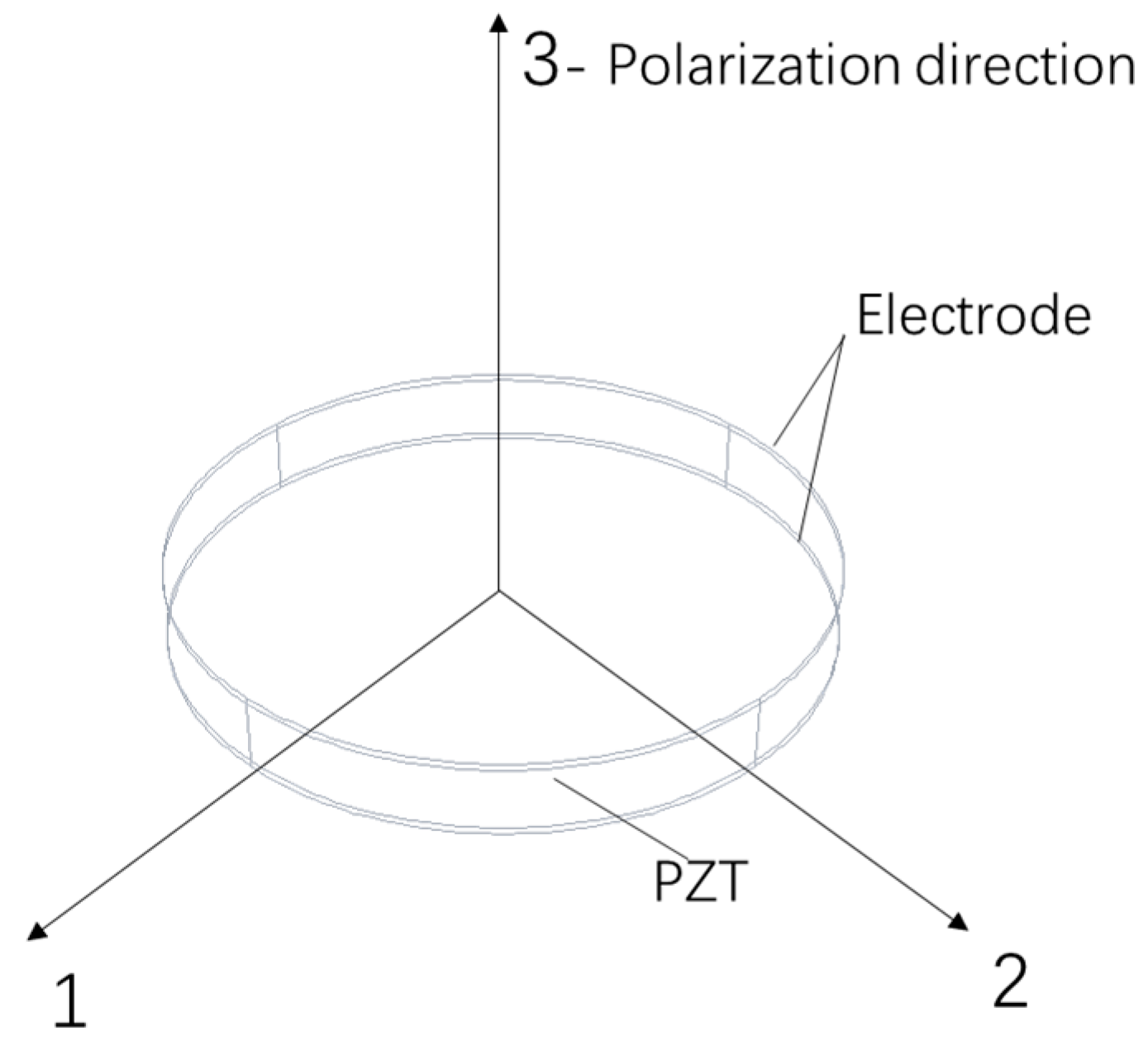
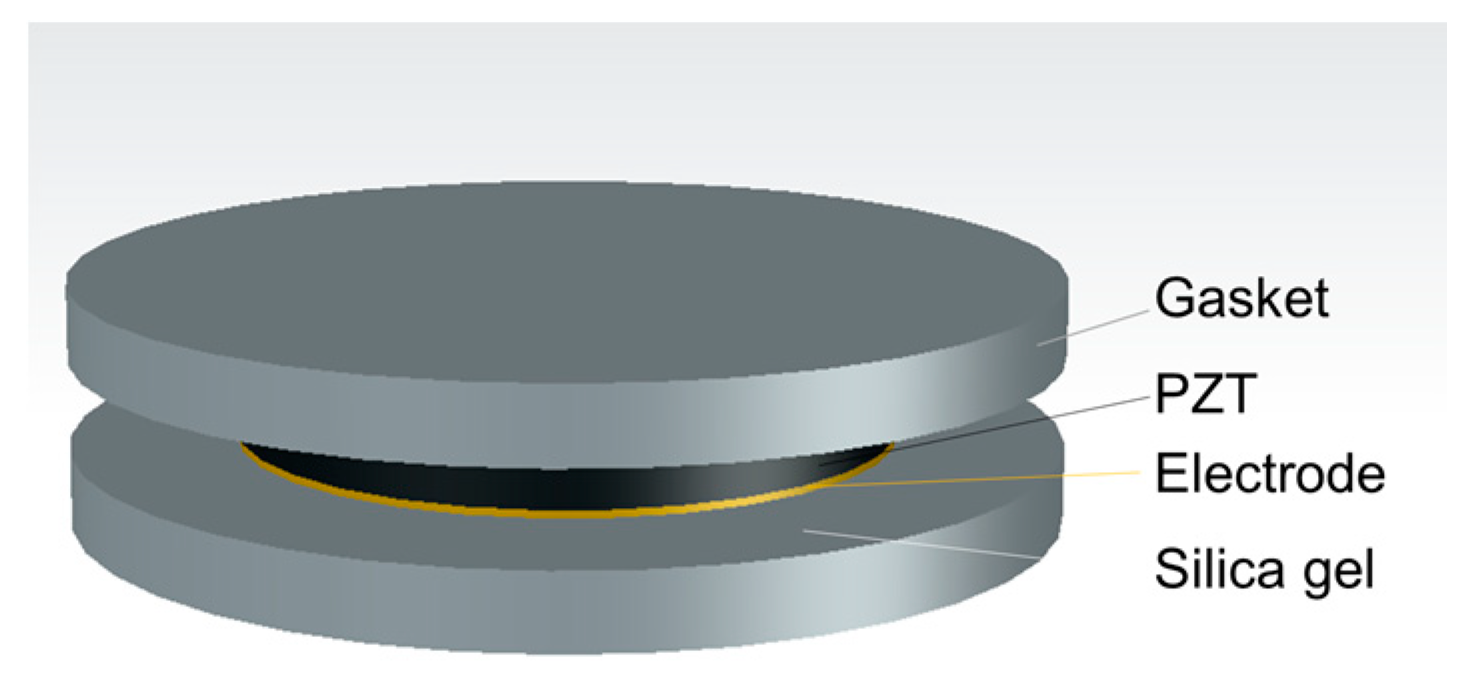

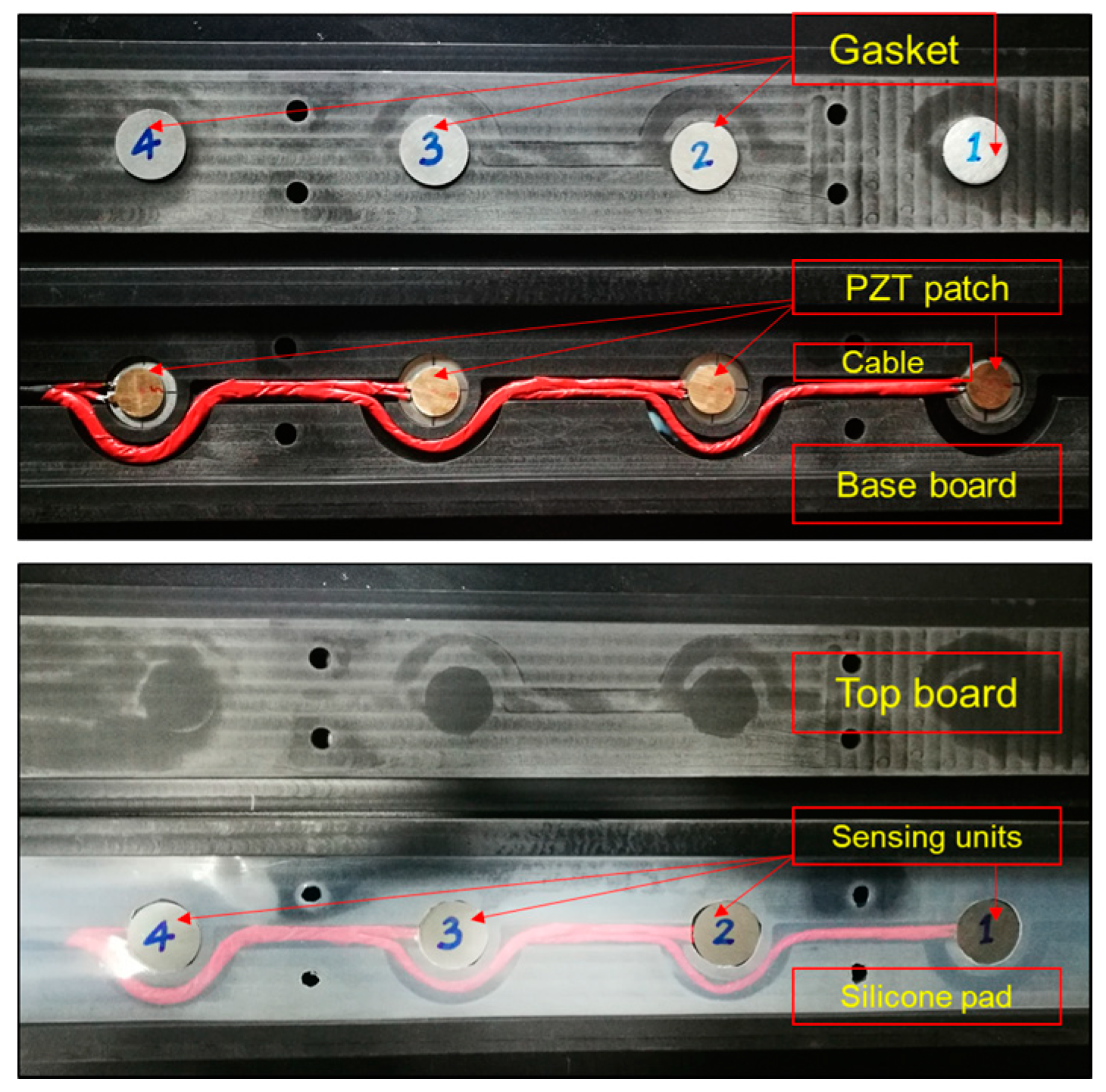
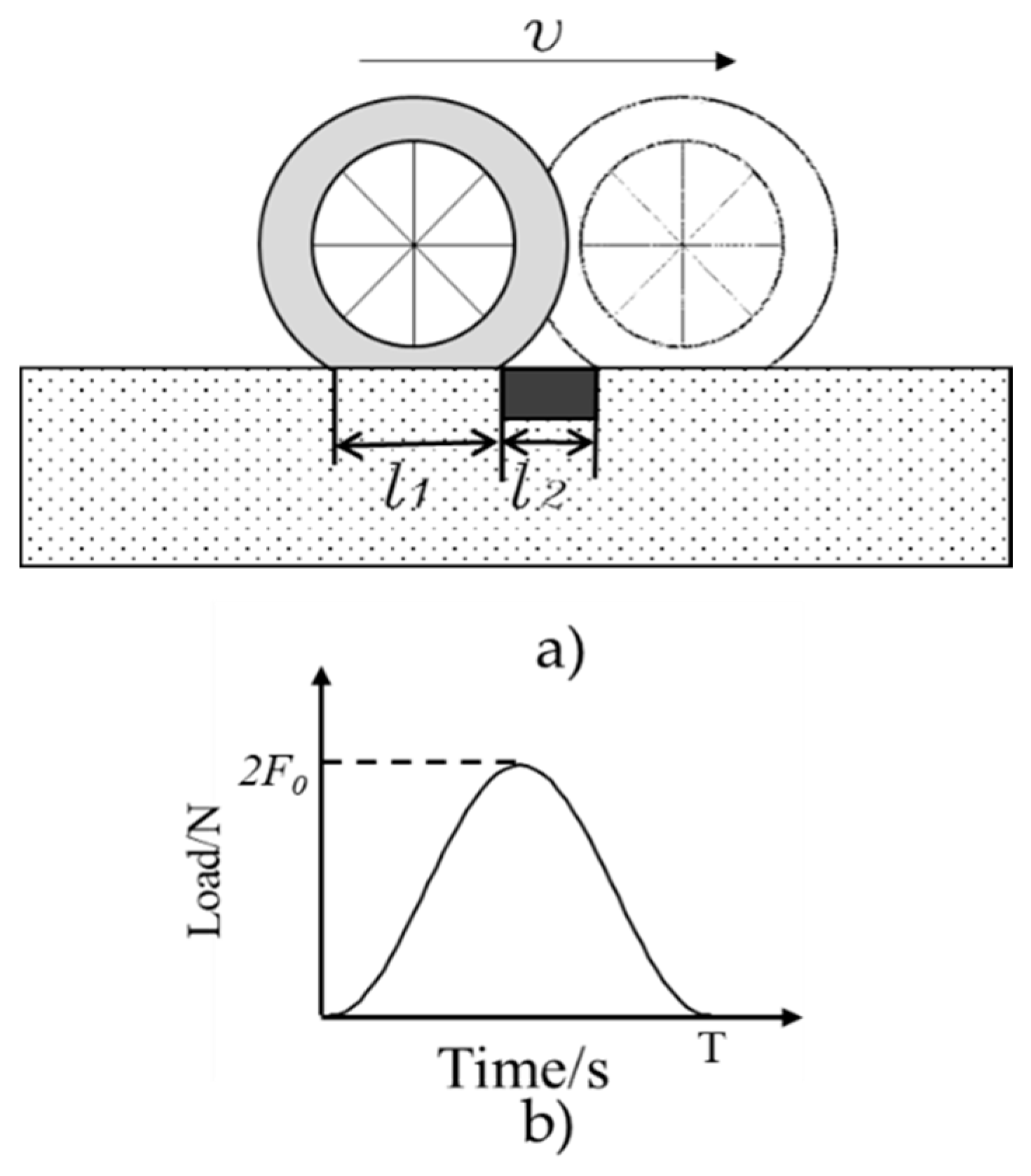
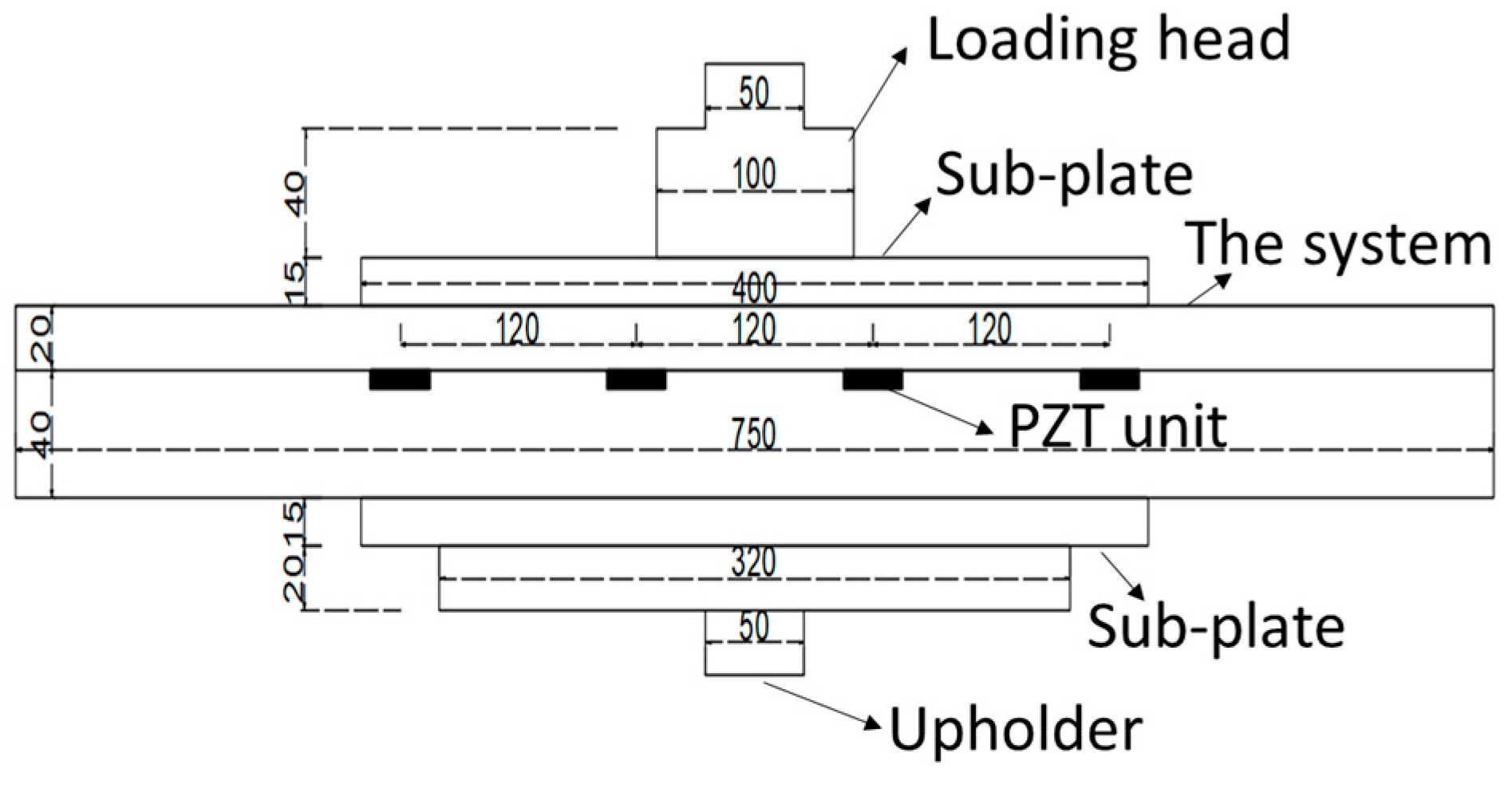

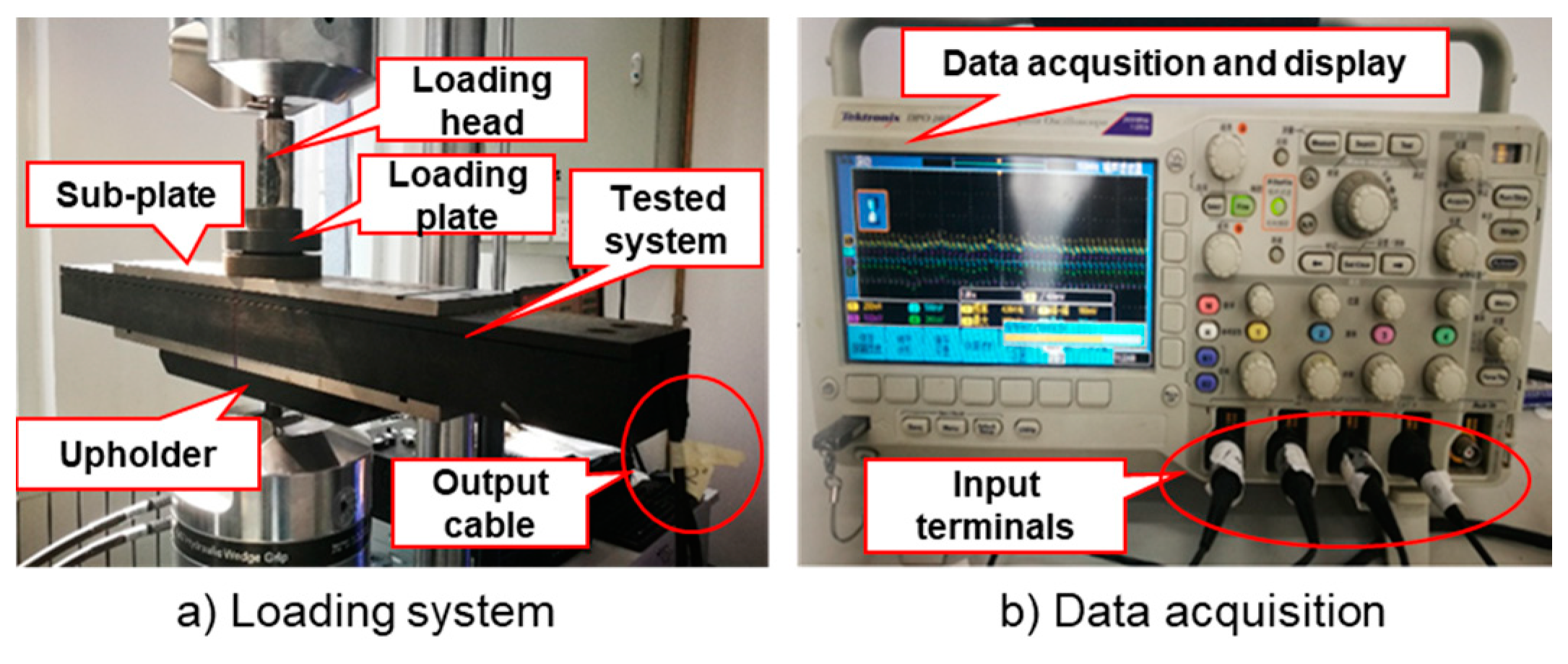


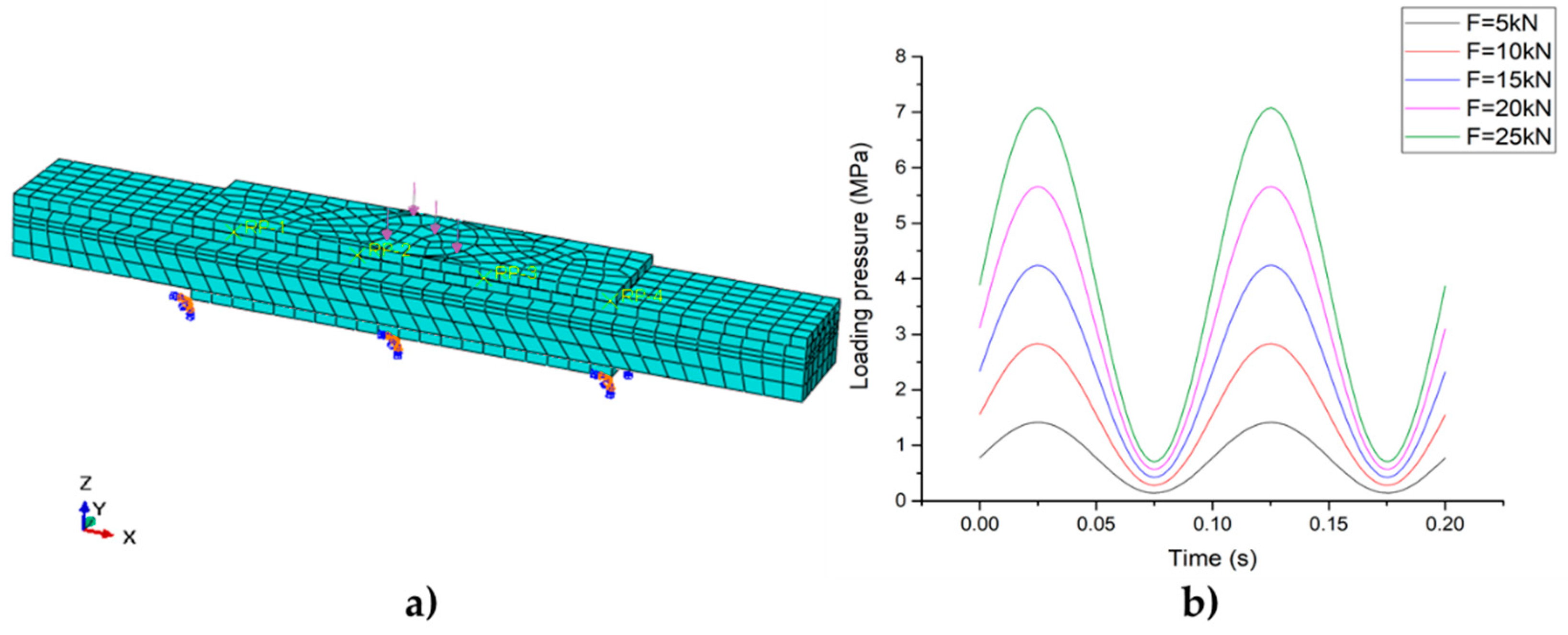

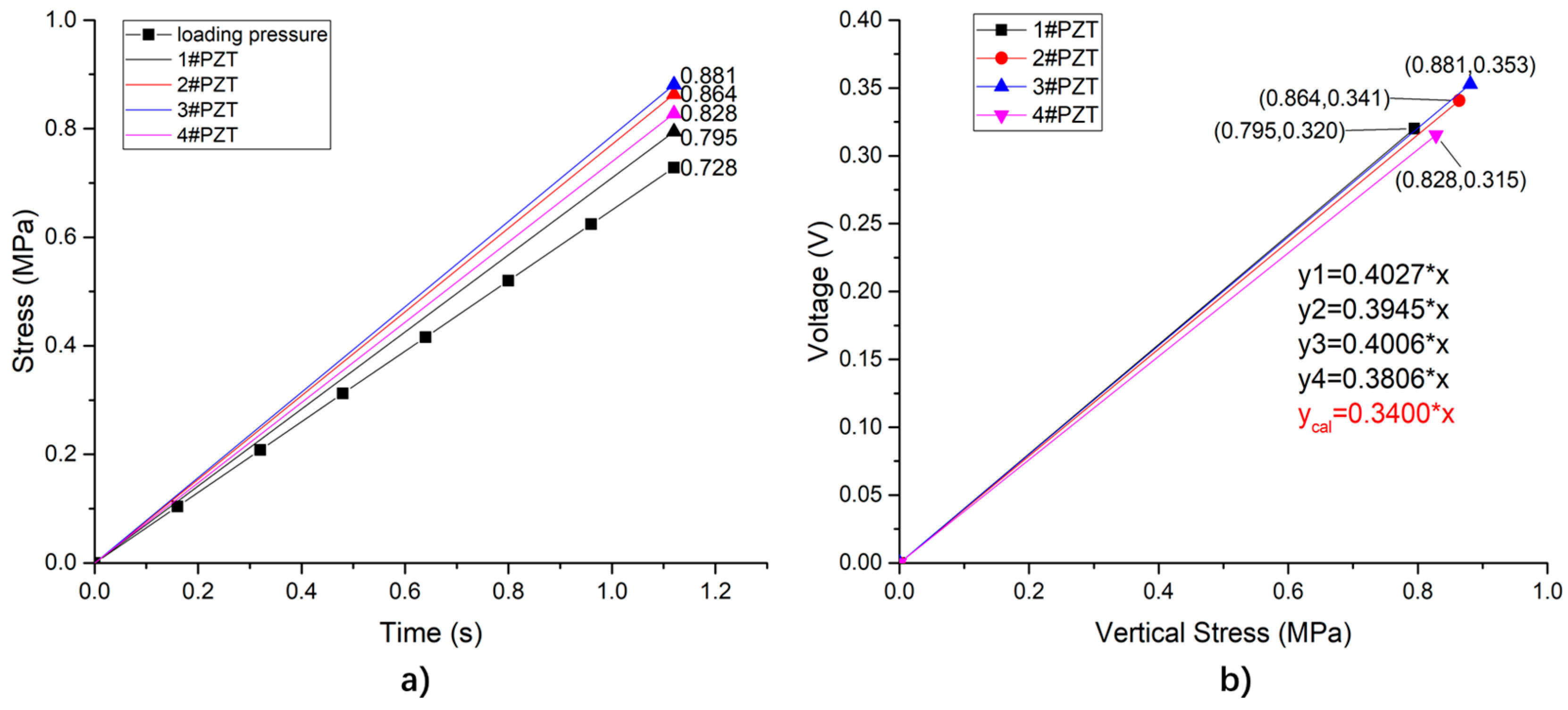

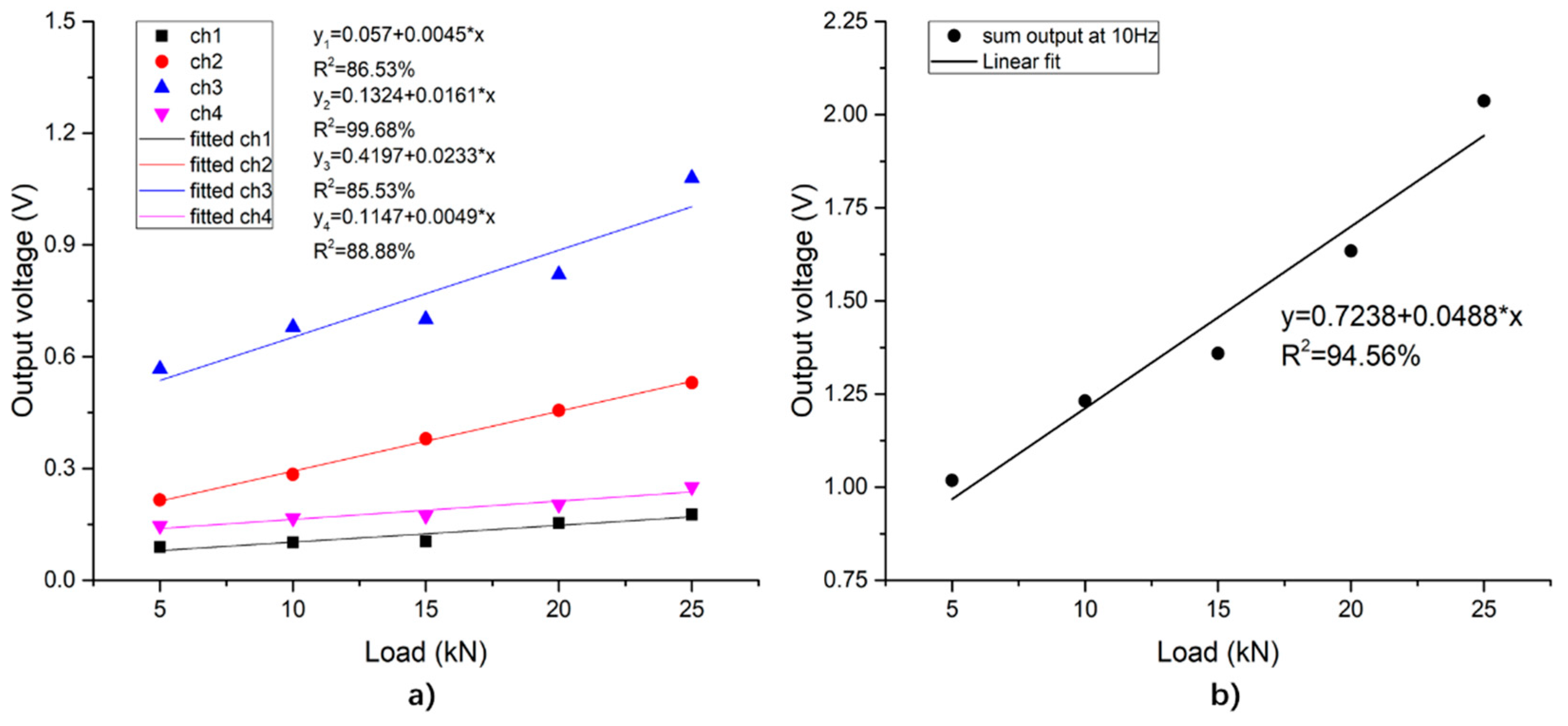
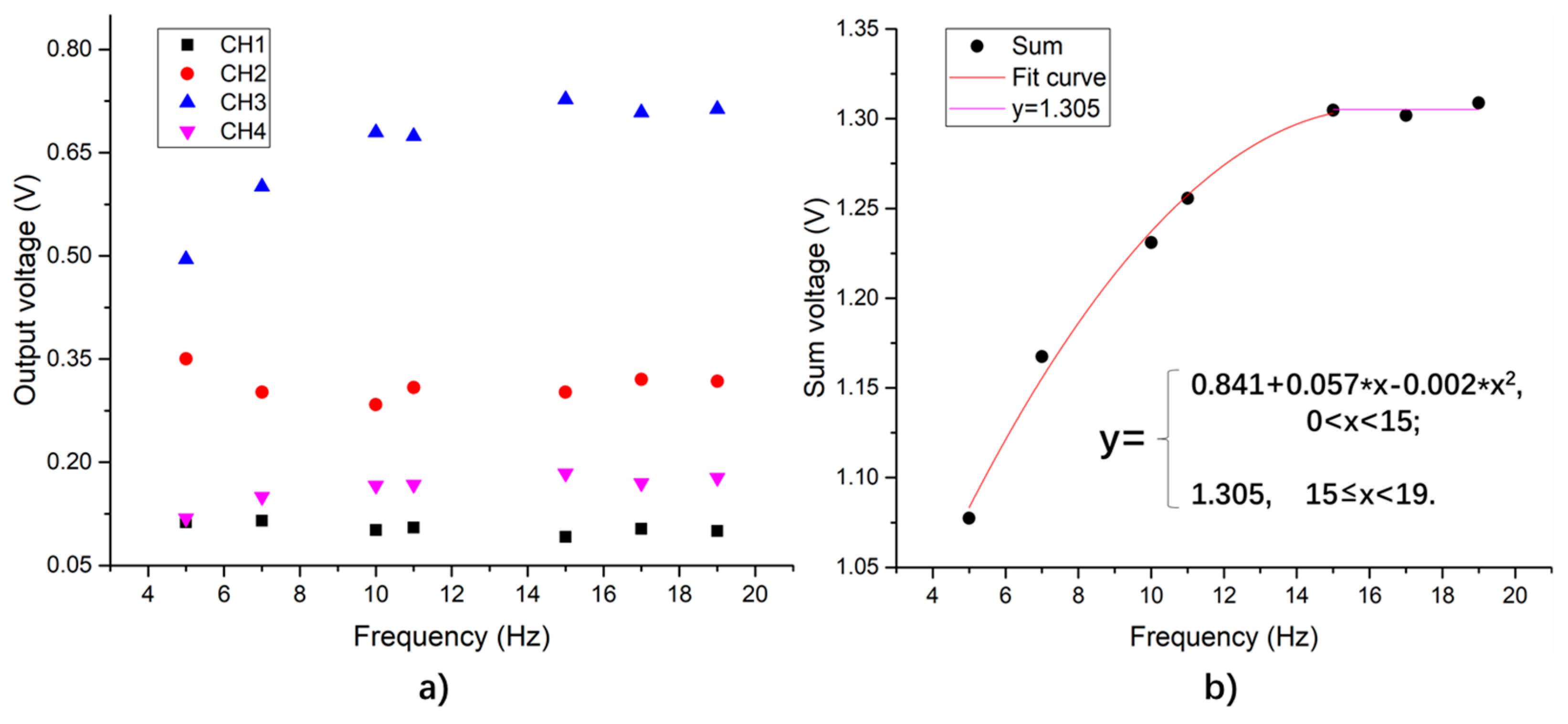

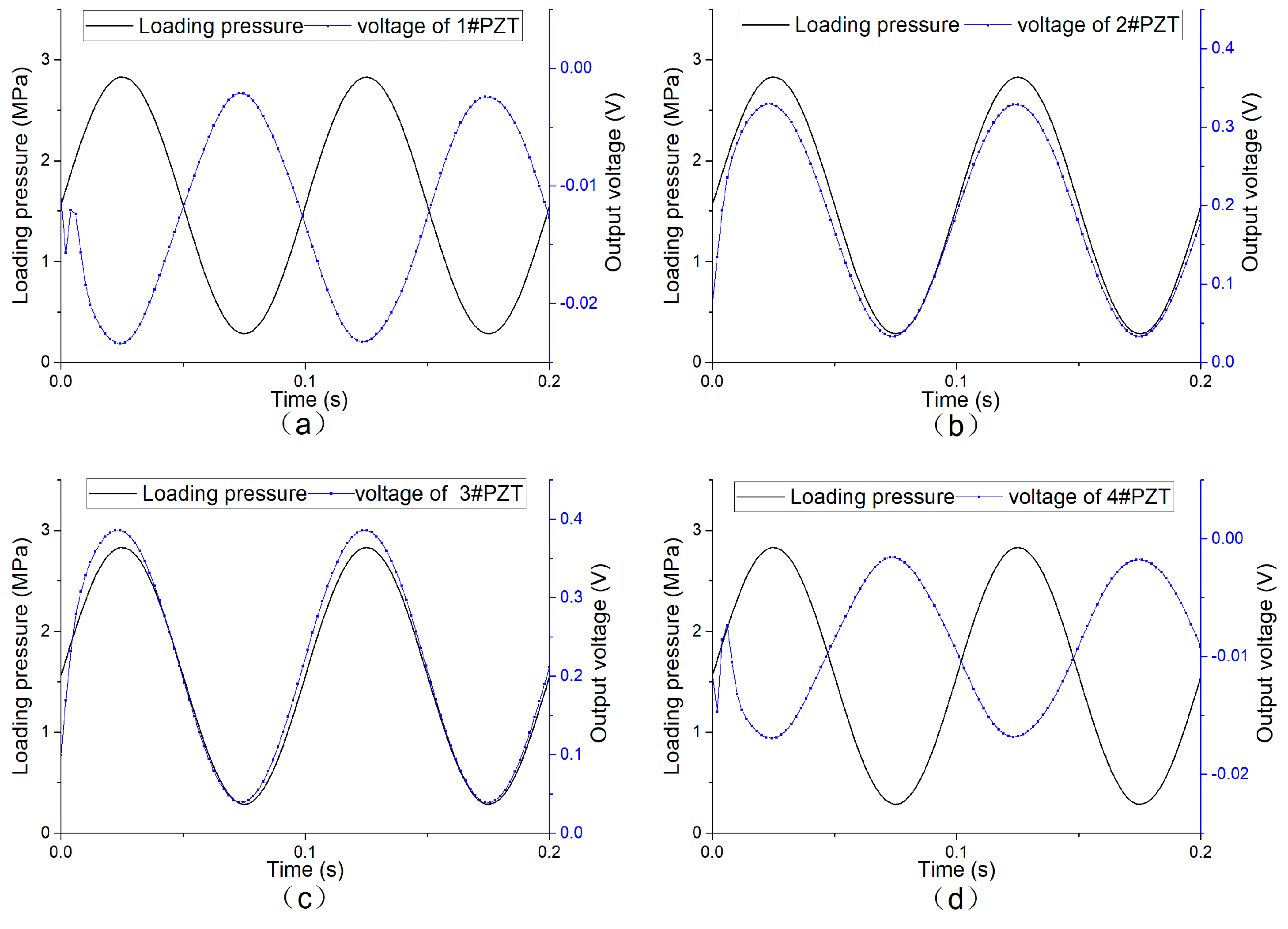
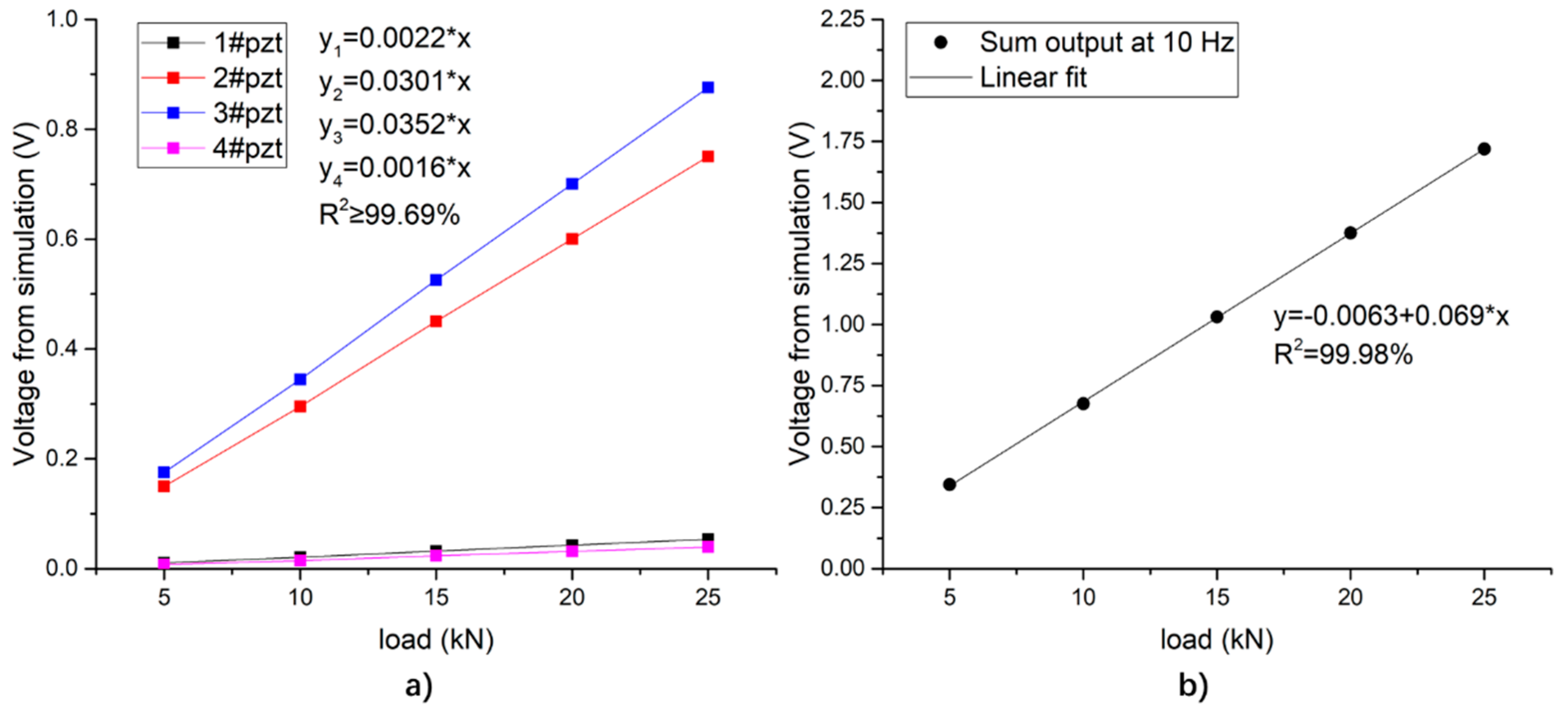

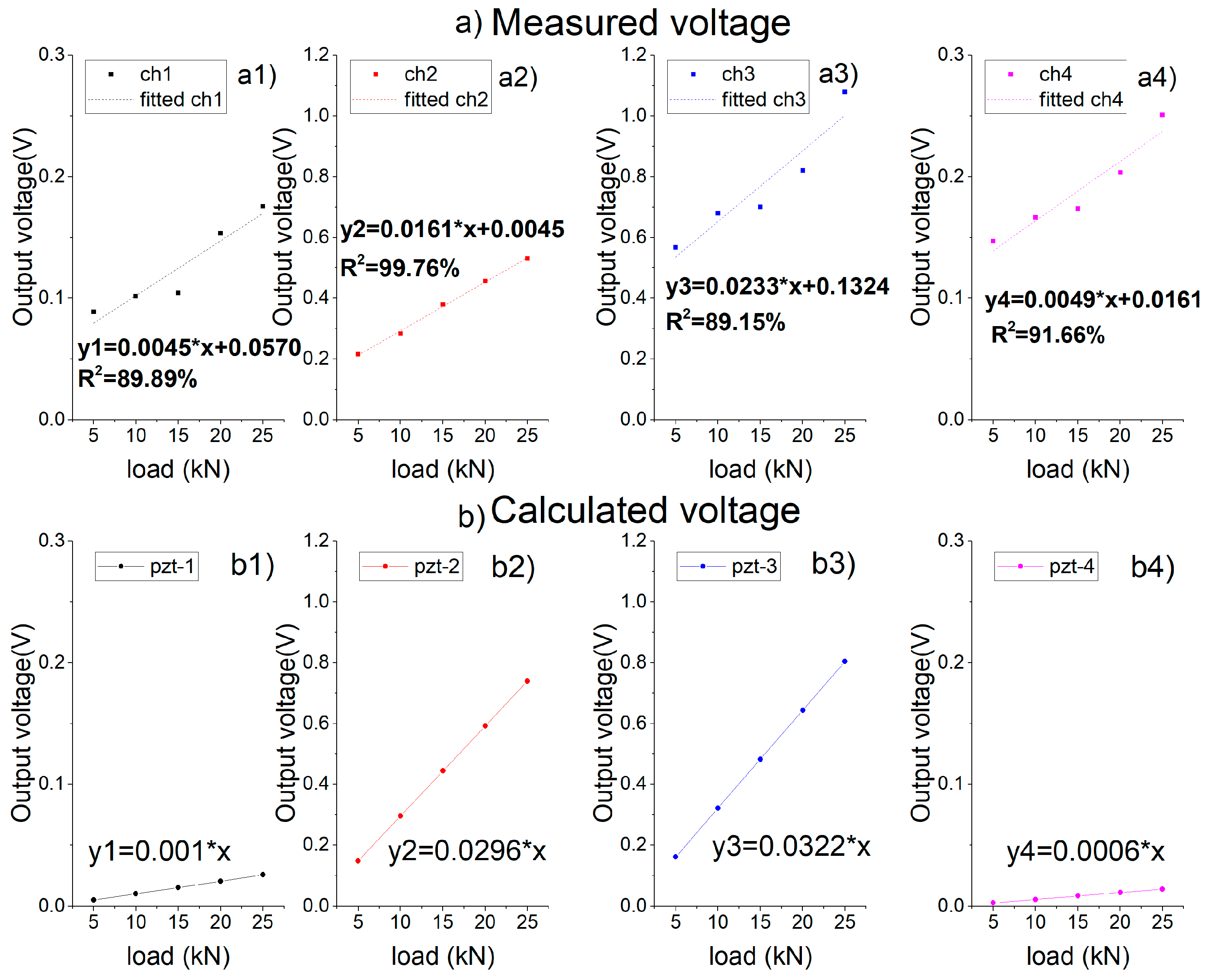

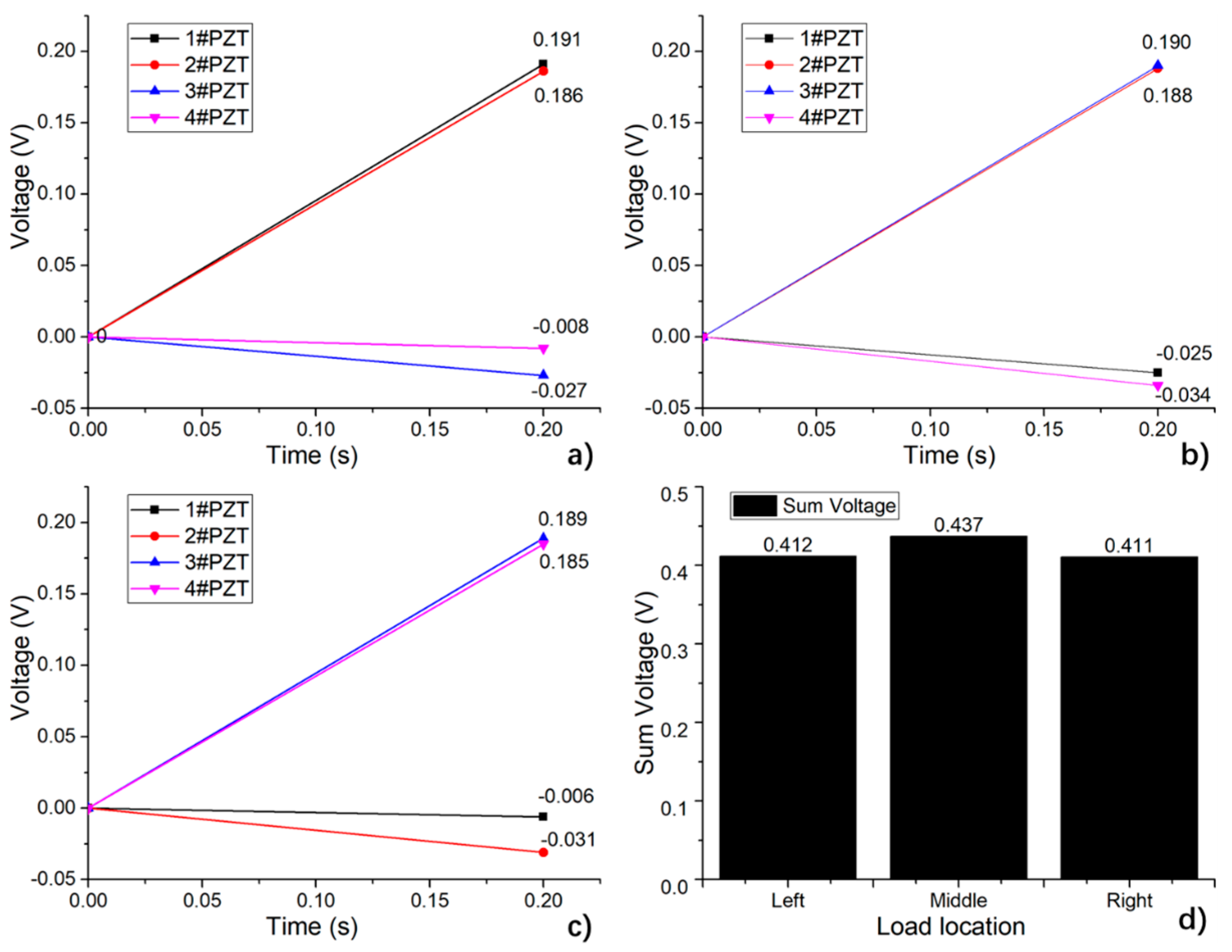
| Name | Qm | R (ohm) | Kp | Cp (nF) | |
|---|---|---|---|---|---|
| Average | 180.38 | 19.54 | 0.59 | 3.785 | 369.9 |
| Layer | Elastic Modulus/MPa | Poisson’s Ratio | Density/(kg/m3) |
|---|---|---|---|
| Fiber-reinforced nylon | 5900 | 0.34 | 1290 |
| PZT-4 | - | - | 7500 |
| Figure | Piezoceramic Sensing System | Piezo-Quartz Sensing System [38] | Piezo-Polymer Cables System [40] | |
|---|---|---|---|---|
| Sensors | Unit cost ($) | 540 | 6232 | 2077 |
| Quantity required per lane | 8 | 4 | 2 | |
| Total ($) | 4320 | 24,928 | 4154 | |
| Measuring system ($) | 6000 | 4072 | 9346 | |
| Installation ($) | 7500 | 12,000 | 6500 | |
| Lane closure ($) [40] | 11,000 | 20,000 | 10,000 | |
| Total cost ($) | 28,820 | 61,000 | 30,000 | |
© 2019 by the authors. Licensee MDPI, Basel, Switzerland. This article is an open access article distributed under the terms and conditions of the Creative Commons Attribution (CC BY) license (http://creativecommons.org/licenses/by/4.0/).
Share and Cite
Zhao, Q.; Wang, L.; Zhao, K.; Yang, H. Development of a Novel Piezoelectric Sensing System for Pavement Dynamic Load Identification. Sensors 2019, 19, 4668. https://doi.org/10.3390/s19214668
Zhao Q, Wang L, Zhao K, Yang H. Development of a Novel Piezoelectric Sensing System for Pavement Dynamic Load Identification. Sensors. 2019; 19(21):4668. https://doi.org/10.3390/s19214668
Chicago/Turabian StyleZhao, Qian, Linbing Wang, Kang Zhao, and Hailu Yang. 2019. "Development of a Novel Piezoelectric Sensing System for Pavement Dynamic Load Identification" Sensors 19, no. 21: 4668. https://doi.org/10.3390/s19214668
APA StyleZhao, Q., Wang, L., Zhao, K., & Yang, H. (2019). Development of a Novel Piezoelectric Sensing System for Pavement Dynamic Load Identification. Sensors, 19(21), 4668. https://doi.org/10.3390/s19214668






